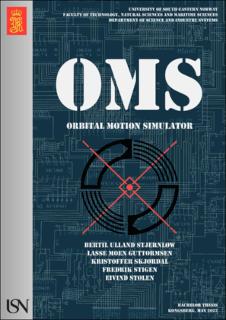| dc.description.abstract | Kongsberg Defence & Aerospace (KDA) delivers Remote Weapon Stations (RWS) configured on top of a rotating turret in offset to the center of rotation, which affects the behavior of the RWS. Therefore, a simulation rig that can test the RWS in this configuration is desired at KDA. The Orbital Motion Simulator (OMS) is designed for this purpose, able to carry an RWS in an offset up to 40 cm of its rotational axis. This bachelor project report contains the dimensioning of the hardware to
the system, the communication channel to the test lab at KDA, and a design of the control system.
System engineering theory is used to create a project model that will ensure progress and an adequate product design. An agile model based on the V-model is made, resulting in iterations where requirements and design approach are reviewed in each iteration to verify that the working process is according to the stakeholder requirements and that the final product will fulfill their needs. Milestones are also effectively used in addition to a Gantt Chart to keep track of the project’s progress, such that a solution is presented at the submission.
The chosen hardware includes a dimensioned servo motor based on the complex loads that occur when the system is placed on top of a motion table to complete the simulation rig. Further, a servo drive is needed to supply the servo motor according to the desired torque. To control the OMS, a position sensor for the main axis of rotation is chosen to produce feedback on the angular displacement of the position. Finally, an embedded PC is selected to implement the control system.
Multiple controlling methods were addressed, but the final design solution is a PID controller. The motor will be controlled by the servo drive’s internal control system of angular velocity. The angular position of the OMS will be controlled by the embedded PC implemented with a PID controller, thus creating a cascade regulation system that is effective against disturbances.
The OMS system will be operated at KDA’s test lab. Therefore, a communication channel using gRPC over Ethernet is established such that the computers already stationed at the lab can be used to control the system. This communication protocol is compatible with multiple programming languages and includes effective data transmission. A Graphical User Interface (GUI) is also designed for the more straightforward operation of the system.
To verify our design, different testing methods are executed, and a prototype is created to verify the control system. The prototype was able to rotate 180 degrees in under 2 seconds with an accuracy of 0.5 degrees, equal to 0.3 % error, which is an adequate performance from a handmade system. Furthermore, a final system design solution is presented to KDA. Regardless, guidance for future work is present since the final assembly and commissioning of the OMS system remains. Experience regarding the prototype will be presented such that the remaining work can be done effectively and accurately. | en_US |
